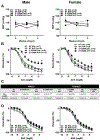Endothelial PPARγ (Peroxisome Proliferator-Activated Receptor-γ) Protects From Angiotensin II-Induced Endothelial Dysfunction in Adult Offspring Born From Pregnancies Complicated by Hypertension
- PMID: 31104564
- PMCID: PMC6561821
- DOI: 10.1161/HYPERTENSIONAHA.119.13101
Endothelial PPARγ (Peroxisome Proliferator-Activated Receptor-γ) Protects From Angiotensin II-Induced Endothelial Dysfunction in Adult Offspring Born From Pregnancies Complicated by Hypertension
Abstract
Preeclampsia is a hypertensive disorder of pregnancy associated with vascular dysfunction and cardiovascular risk to offspring. We hypothesize that endothelial PPARγ (peroxisome proliferator-activated receptor-γ) provides cardiovascular protection in offspring from pregnancies complicated by hypertension. C57BL/6J dams were bred with E-V290M sires, which express a dominant-negative allele of PPARγ selectively in the endothelium. Arginine vasopressin was infused throughout gestation. Vasopressin elevated maternal blood pressure at gestational day 14 to 15 and urinary protein at day 17 consistent. Systolic blood pressure and vasodilation responses to acetylcholine were similar in vasopressin-exposed offspring compared to offspring from control pregnancies. We treated offspring with a subpressor dose of angiotensin II to test if hypertension during pregnancy predisposes offspring to hypertension. Male and female angiotensin II-treated E-V290M offspring from vasopressin-exposed but not control pregnancy exhibited significant impairment in acetylcholine-induced relaxation in carotid artery. Endothelial dysfunction in angiotensin II-treated E-V290M vasopressin-exposed offspring was attenuated by tempol, an effect which was more prominent in male offspring. Nrf2 (nuclear factor-E2-related factor) protein levels were significantly elevated in aorta from male E-V290M offspring, but not female offspring compared to controls. Blockade of ROCK (Rho-kinase) signaling and incubation with a ROCK2-specific inhibitor improved endothelial function in both male and female E-V290M offspring from vasopressin-exposed pregnancy. Our data suggest that interference with endothelial PPARγ in offspring from vasopressin-exposed pregnancies increases the risk for endothelial dysfunction on exposure to a cardiovascular stressor in adulthood. This implies that endothelial PPARγ provides protection to cardiovascular stressors in offspring of a pregnancy complicated by hypertension and perhaps in preeclampsia.
Keywords: angiotensin II; blood pressure; endothelium; preeclampsia; pregnancy; vasodilation.
Figures






Similar articles
-
PPARγ and RhoBTB1 in hypertension.Curr Opin Nephrol Hypertens. 2020 Mar;29(2):161-170. doi: 10.1097/MNH.0000000000000579. Curr Opin Nephrol Hypertens. 2020. PMID: 31789920 Free PMC article. Review.
-
Interference with PPARγ in endothelium accelerates angiotensin II-induced endothelial dysfunction.Physiol Genomics. 2016 Feb;48(2):124-34. doi: 10.1152/physiolgenomics.00087.2015. Epub 2015 Nov 3. Physiol Genomics. 2016. PMID: 26534936 Free PMC article.
-
Genetic Interference With Endothelial PPAR-γ (Peroxisome Proliferator-Activated Receptor-γ) Augments Effects of Angiotensin II While Impairing Responses to Angiotensin 1-7.Hypertension. 2017 Sep;70(3):559-565. doi: 10.1161/HYPERTENSIONAHA.117.09358. Epub 2017 Jul 3. Hypertension. 2017. PMID: 28674038 Free PMC article.
-
Endothelial PPARγ (Peroxisome Proliferator-Activated Receptor-γ) Is Essential for Preventing Endothelial Dysfunction With Aging.Hypertension. 2018 Jul;72(1):227-234. doi: 10.1161/HYPERTENSIONAHA.117.10799. Epub 2018 May 7. Hypertension. 2018. PMID: 29735632 Free PMC article.
-
Molecular mechanisms regulating vascular tone by peroxisome proliferator activated receptor gamma.Curr Opin Nephrol Hypertens. 2015 Mar;24(2):123-30. doi: 10.1097/MNH.0000000000000103. Curr Opin Nephrol Hypertens. 2015. PMID: 25587903 Free PMC article. Review.
Cited by
-
PPARγ and RhoBTB1 in hypertension.Curr Opin Nephrol Hypertens. 2020 Mar;29(2):161-170. doi: 10.1097/MNH.0000000000000579. Curr Opin Nephrol Hypertens. 2020. PMID: 31789920 Free PMC article. Review.
-
Immune and Metabolic Mechanisms of Endothelial Dysfunction.Int J Mol Sci. 2024 Dec 12;25(24):13337. doi: 10.3390/ijms252413337. Int J Mol Sci. 2024. PMID: 39769104 Free PMC article. Review.
-
Perinatal Exposure of Dams to a High Salt Diet Impaired Vascular Function and Elevated Biomarkers of Inflammation in the Offspring.Clin Med Insights Cardiol. 2025 Aug 17;19:11795468251358906. doi: 10.1177/11795468251358906. eCollection 2025. Clin Med Insights Cardiol. 2025. PMID: 40837122 Free PMC article.
-
Increased Susceptibility of Mice Lacking Renin-b to Angiotensin II-Induced Organ Damage.Hypertension. 2020 Aug;76(2):468-477. doi: 10.1161/HYPERTENSIONAHA.120.14972. Epub 2020 Jun 8. Hypertension. 2020. PMID: 32507043 Free PMC article.
-
The Potential Role of PPARs in the Fetal Origins of Adult Disease.Cells. 2022 Nov 2;11(21):3474. doi: 10.3390/cells11213474. Cells. 2022. PMID: 36359869 Free PMC article. Review.
References
-
- Sandgren JA, Deng G, Linggonegoro DW, Scroggins SM, Perschbacher KJ, Nair AR, Nishimura TE, Zhang SY, Agbor LN, Wu J, Keen HL, Naber MC, Pearson NA, Zimmerman KA, Weiss RM, Bowdler NC, Usachev YM, Santillan DA, Potthoff MJ, Pierce GL, Gibson-Corley KN, Sigmund CD, Santillan MK and Grobe JL. Arginine vasopressin infusion is sufficient to model clinical features of preeclampsia in mice. JCI Insight. 2018;3. - PMC - PubMed
-
- Alsnes IV, Vatten LJ, Fraser A, Bjorngaard JH, Rich-Edwards J, Romundstad PR and Asvold BO. Hypertension in Pregnancy and Offspring Cardiovascular Risk in Young Adulthood: Prospective and Sibling Studies in the HUNT Study (Nord-Trondelag Health Study) in Norway. Hypertension. 2017;69:591–598. - PubMed
-
- Esplin MS, Fausett MB, Fraser A, Kerber R, Mineau G, Carrillo J and Varner MW. Paternal and maternal components of the predisposition to preeclampsia. N Engl J Med. 2001;344:867–872. - PubMed
Publication types
MeSH terms
Substances
Grants and funding
LinkOut - more resources
Full Text Sources
Medical

